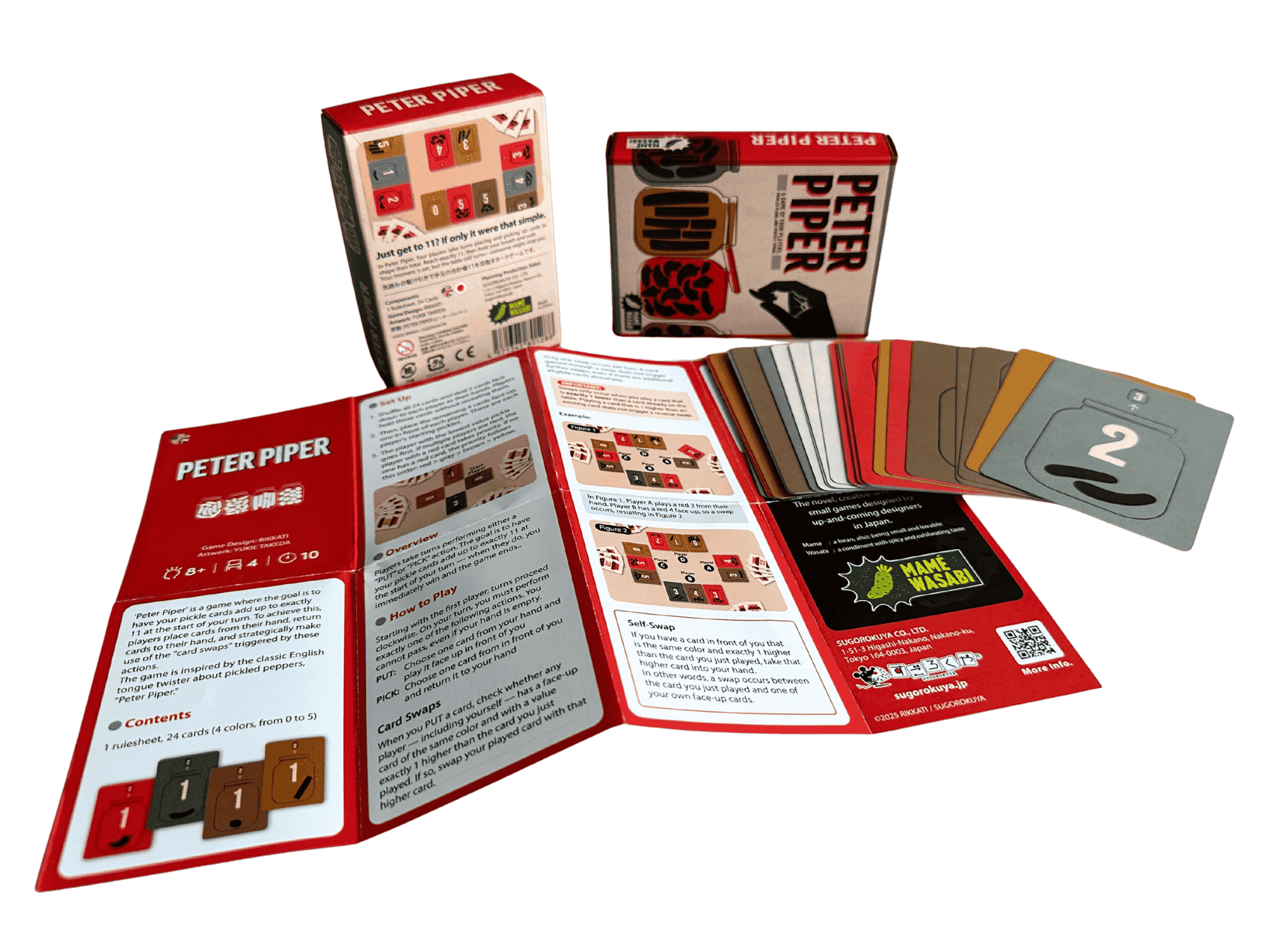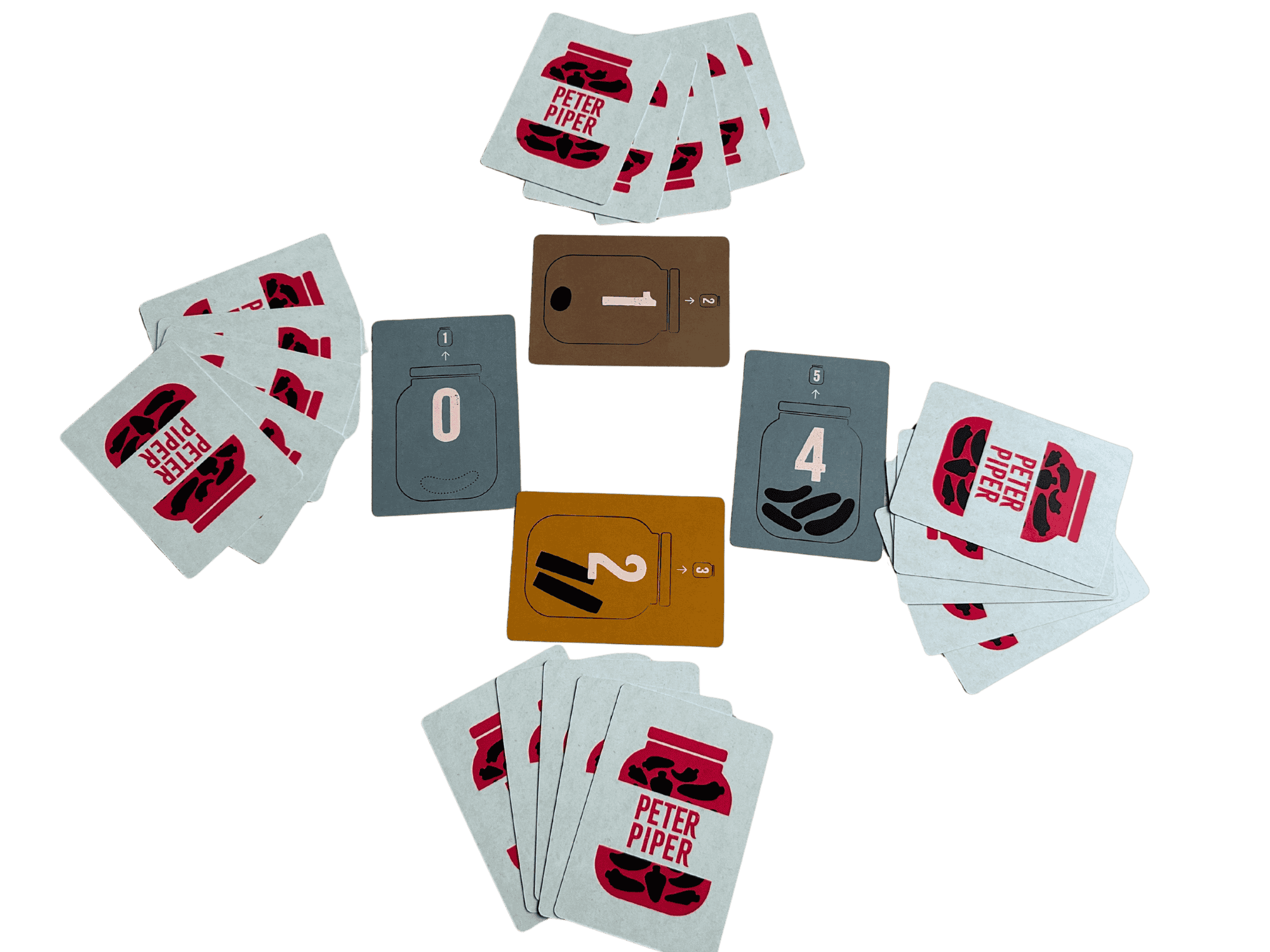Peter Piper
Ever stumbled over the tongue-twister “Peter Piper picked a peck of pickled peppers” and thought, this could be a game? Well, it is now! Peter Piper is a light, strategic card game that turns that famous rhyme into a fun test of timing, tactics, and a little bit of tongue-twisting luck.
Published by Mamé Wasabi and designed by Rikkati, Peter Piper is a fast-paced filler for 2 to 4 players that takes around 10 minutes to play: perfect for your next game night warm-up or as a light-hearted closer after a heavy strategy session.
The Premise
In Peter Piper, your goal is simple: but oh, it rarely feels that way. You’re trying to make the total value of your “pickle” cards in front of you equal exactly 11 at the start of your turn. Do that, and you win immediately! But getting there means juggling swaps, clever plays, and reading your opponents’ every move.
Think of it as a mix of tactical card placement and subtle math wizardry - with a dash of spice.
Setting Up the Table
The components of Peter Piper
Here’s how to get your pickle patch ready:
Shuffle all 24 cards and deal 5 face-down cards to each player. This is your hand - keep them secret!
Deal 1 face-up cards in front of each player (totaling 4 on the table). These are your starting “pickle” cards.
The player with the lowest total value among their face-up cards goes first. If there’s a tie, red cards take priority (then gray, brown, and yellow).
You’re now ready to play!
How to Play
On your turn, you can do one of two things:
PUT a card from your hand into your display, or
PICK a face-up card from your display to add to your hand.
Each choice comes with consequences, and possibly a chain reaction of swaps.
PUT
Play a card from your hand into your display. Then, compare your displayed cards to those of the other players, checking if any player has a card of the same color and number +1.
If they do, you must swap your newly played card with that matching one! This can create a delicious domino effect of swaps across the table as the turn unfolds.
There’s also a self-swap rule: if you play a card that’s exactly 1 higher than a face-up card in front of you, you can swap them yourself and tuck the higher card into your hand. It’s a neat little twist that rewards forward thinking.
PICK
Instead of playing a card, you can take one from your own display back into your hand. It’s a great way to rethink your setup or prepare for a strategic play later.
The card deck of Peter Piper
The Art of the Swap
Swapping is where Peter Piper really shines. Your clever play might suddenly hand your opponent the perfect combination, or snatch it away from them.
Winning the Game
The moment your face-up cards total exactly 11 at the start of your turn, you win.
But here’s the kicker: if you hit 11 during your turn, you have to wait until the beginning of your next turn to claim victory. That means your opponents have a full round to mess up your perfect pickle balance!
Why We Love It
What makes Peter Piper so charming is how much strategy fits into such a small, quick game. Every decision feels meaningful: do you risk playing a card that might trigger a massive swap? Or do you bide your time and pick carefully?
It’s fast, chaotic, and surprisingly clever, with a simple math puzzle at its heart. It also shines as a gateway game: easy to teach, easy to play, but hard to win.
The display of cards in a match of Peter Piper
What Could be Better
While Peter Piper delivers a lot of charm in a tiny package, its simplicity can occasionally feel like a double-edged sword. The minimal components and quick turns make it wonderfully accessible, but they also mean the game may lack long-term depth for players who prefer more strategic heft. Additionally, the requirement for exactly four players can make it feel less dynamic and unaccessible for audiences of different sizes. A bit more variability, either through expanded card effects or optional modules, could boost replay value and broaden its appeal.
Final Thoughts
If you’re looking for a light, portable card game that mixes math, memory, and mild mischief, Peter Piper deserves a spot on your shelf. It’s a bite-sized brain teaser with plenty of replayability, and the perfect way to test your tongue and your tactics.
Overall, the game is fun, although its minimalism and the street requirement of 4 players can be a limiting factor for some. For these reasons, we rate Peter Piper as an 8/10.
Next time you’re at game night, channel your inner Peter Piper, and see if you can “pick your pickle” just right. And if you’d like to be informed about new game releases, don’t forget to subscribe to our newsletter!


